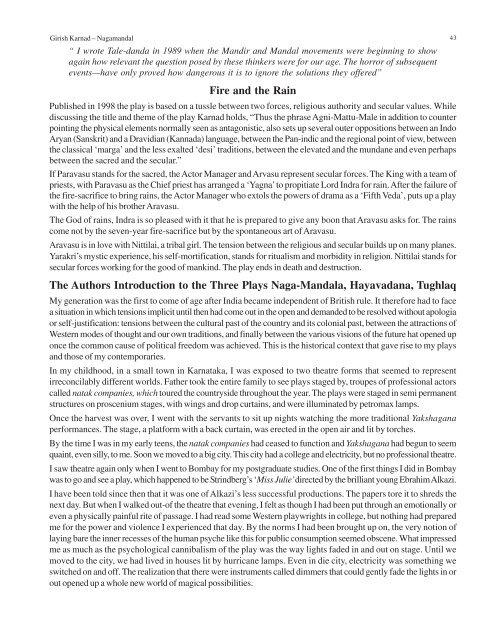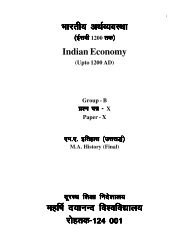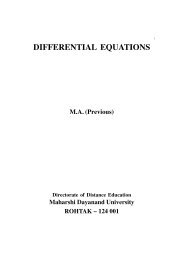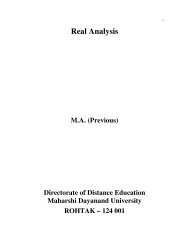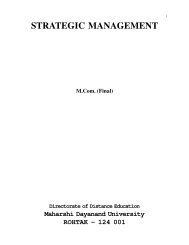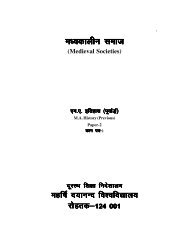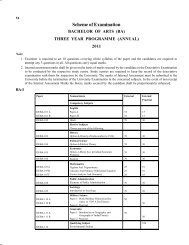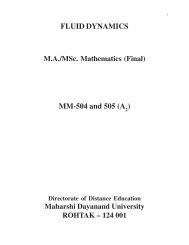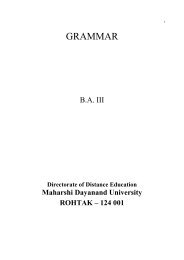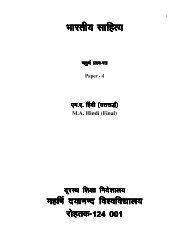LITERATURE AND GENDER - Maharshi Dayanand University, Rohtak
LITERATURE AND GENDER - Maharshi Dayanand University, Rohtak
LITERATURE AND GENDER - Maharshi Dayanand University, Rohtak
Create successful ePaper yourself
Turn your PDF publications into a flip-book with our unique Google optimized e-Paper software.
Girish Karnad – Nagamandal“ I wrote Tale-danda in 1989 when the Mandir and Mandal movements were beginning to showagain how relevant the question posed by these thinkers were for our age. The horror of subsequentevents—have only proved how dangerous it is to ignore the solutions they offered”43Fire and the RainPublished in 1998 the play is based on a tussle between two forces, religious authority and secular values. Whilediscussing the title and theme of the play Karnad holds, “Thus the phrase Agni-Mattu-Male in addition to counterpointing the physical elements normally seen as antagonistic, also sets up several outer oppositions between an IndoAryan (Sanskrit) and a Dravidian (Kannada) language, between the Pan-indic and the regional point of view, betweenthe classical ‘marga’ and the less exalted ‘desi’ traditions, between the elevated and the mundane and even perhapsbetween the sacred and the secular.”If Paravasu stands for the sacred, the Actor Manager and Arvasu represent secular forces. The King with a team ofpriests, with Paravasu as the Chief priest has arranged a ‘Yagna’ to propitiate Lord Indra for rain. After the failure ofthe fire-sacrifice to bring rains, the Actor Manager who extols the powers of drama as a ‘Fifth Veda’, puts up a playwith the help of his brother Aravasu.The God of rains, Indra is so pleased with it that he is prepared to give any boon that Aravasu asks for. The rainscome not by the seven-year fire-sacrifice but by the spontaneous art of Aravasu.Aravasu is in love with Nittilai, a tribal girl. The tension between the religious and secular builds up on many planes.Yarakri’s mystic experience, his self-mortification, stands for ritualism and morbidity in religion. Nittilai stands forsecular forces working for the good of mankind. The play ends in death and destruction.The Authors Introduction to the Three Plays Naga-Mandala, Hayavadana, TughlaqMy generation was the first to come of age after India became independent of British rule. It therefore had to facea situation in which tensions implicit until then had come out in the open and demanded to be resolved without apologiaor self-justification: tensions between the cultural past of the country and its colonial past, between the attractions ofWestern modes of thought and our own traditions, and finally between the various visions of the future hat opened uponce the common cause of political freedom was achieved. This is the historical context that gave rise to my playsand those of my contemporaries.In my childhood, in a small town in Karnataka, I was exposed to two theatre forms that seemed to representirreconcilably different worlds. Father took the entire family to see plays staged by, troupes of professional actorscalled natak companies, which toured the countryside throughout the year. The plays were staged in semi permanentstructures on proscenium stages, with wings and drop curtains, and were illuminated by petromax lamps.Once the harvest was over, I went with the servants to sit up nights watching the more traditional Yakshaganaperformances. The stage, a platform with a back curtain, was erected in the open air and lit by torches.By the time I was in my early teens, the natak companies had ceased to function and Yakshagana had begun to seemquaint, even silly, to me. Soon we moved to a big city. This city had a college and electricity, but no professional theatre.I saw theatre again only when I went to Bombay for my postgraduate studies. One of the first things I did in Bombaywas to go and see a play, which happened to be Strindberg’s ‘Miss Julie’ directed by the brilliant young Ebrahim Alkazi.I have been told since then that it was one of Alkazi’s less successful productions. The papers tore it to shreds thenext day. But when I walked out-of the theatre that evening, I felt as though I had been put through an emotionally oreven a physically painful rite of passage. I had read some Western playwrights in college, but nothing had preparedme for the power and violence I experienced that day. By the norms I had been brought up on, the very notion oflaying bare the inner recesses of the human psyche like this for public consumption seemed obscene. What impressedme as much as the psychological cannibalism of the play was the way lights faded in and out on stage. Until wemoved to the city, we had lived in houses lit by hurricane lamps. Even in die city, electricity was something weswitched on and off. The realization that there were instruments called dimmers that could gently fade the lights in orout opened up a whole new world of magical possibilities.


